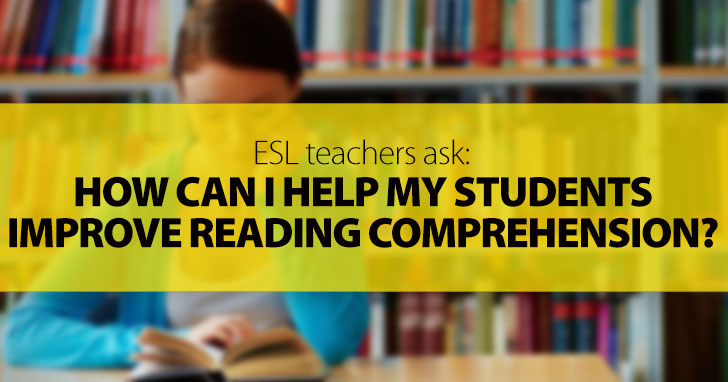“I typically teach students who sit for major international examinations like the Cambridge ESOL or the TOEFL. Most of them struggle with the reading passages. The problem is they need to understand these texts, but they need to do it fast because of the time constraints. How can I help students improve reading comprehension?” *
Sometimes students need to improve reading comprehension to perform in stressful situations like international examinations; sometimes they need to improve reading comprehension because it simply makes sense.
It’s a skill that could help them in their job performance or overall communication in English. Whatever the case may be, there are three key aspects to improving reading comprehension: vocabulary, reading strategies and practice.
Note: For the purposes of this article, we’ll focus on reading comprehension for practical purposes like test taking, not reading for pleasure.

3 Ways to Improve Reading Comprehension
-
1
Build Vocabulary
More often than not, reading comprehension is dependent on the vocabulary students know and understand. The more technical and difficult the reading texts become, the more the reader must rely on grasping the vocabulary. The readings that appear in the TOEFL for example are particularly academic or scientific, not the type of thing any student can understand without some serious vocabulary building. So here’s what you can do to build your students’ vocabulary:
- Find out exactly what type of vocabulary they need. Some exam preparation materials even include vocabulary lists. Get your hands on past papers and samples to get an idea of the difficulty level.
- Teach and practice new words in clusters that make sense, like words related to health, travel, etc...
- Remember the stages in vocabulary acquisition: first, students notice a new word; secondly, they recognize the new word with help; next, they recognize the word on their own; and finally, they can both recognize and use the word on their own. If you give your class activities that target each of these stages, they will be better equipped to acquire the vocabulary they need.
-
2
Implement Reading Strategies
As students work to acquire the vocabulary they will need to better comprehend texts, they will also need to learn some reading strategies that will be useful for them. Let's bear in mind that we’re dealing with texts they need to read and comprehend FAST. They don’t have the time to read slowly, re-read, take notes or look up words in the dictionary. So, which reading strategies will be the most useful for them? There are mainly two: skimming and scanning.
- Skimming – Skimming is a reading strategy that involves going over a text quickly to get the main idea. You can also pick up on the tone, and see how the text is divided or organized, like introduction, main body and conclusion (this will be useful for later). Finally, you may quickly note some information that may be key, like dates, numbers or other specifics (which may also be of use later). This is the type of reading students may do as they approach a text for the first time, often because they don’t have time for a thorough reading.
- Scanning – Scanning involves searching the text for specific information. This is what students typically do once they start working with the multiple choice questions. They read the questions, then search the text for the right answer. They can do this search faster because they’ve already skimmed the text and have an idea as to where they can find each piece of information.
Some may argue that students should sit back and slowly read a text word for word, then simply answer the questions, and move on to the next exercise. But chances are they will have to scan the text for the answers anyway, and unless they’ve completed the other sections of the test super fast, they won’t have time for a thorough reading. This is why skimming and scanning are great strategies to implement.
-
3
Practice
Nothing beats repeated and extended practice. Students must be able to read texts that are similar to those that will appear in the test. Students must also be able to comprehend texts that are similar but are found in real life sources, like newspaper or magazine articles. Finally, they must have plenty of timed practice. Learners need to learn to manage the time they are allotted for the completion of the test sections.
You may think this is all great for exam practice, but the truth is it will also help students in real life situations.
There are plenty of scenarios where students may have to read and comprehend a text under pressure or within a specific time limit. These are not just exam reading skills; these are essential skills that will help them communicate more effectively in English.
P.S. If you enjoyed this article, please help spread it by clicking one of those sharing buttons below. And if you are interested in more, you should follow our Facebook page where we share more about creative, non-boring ways to teach English.







